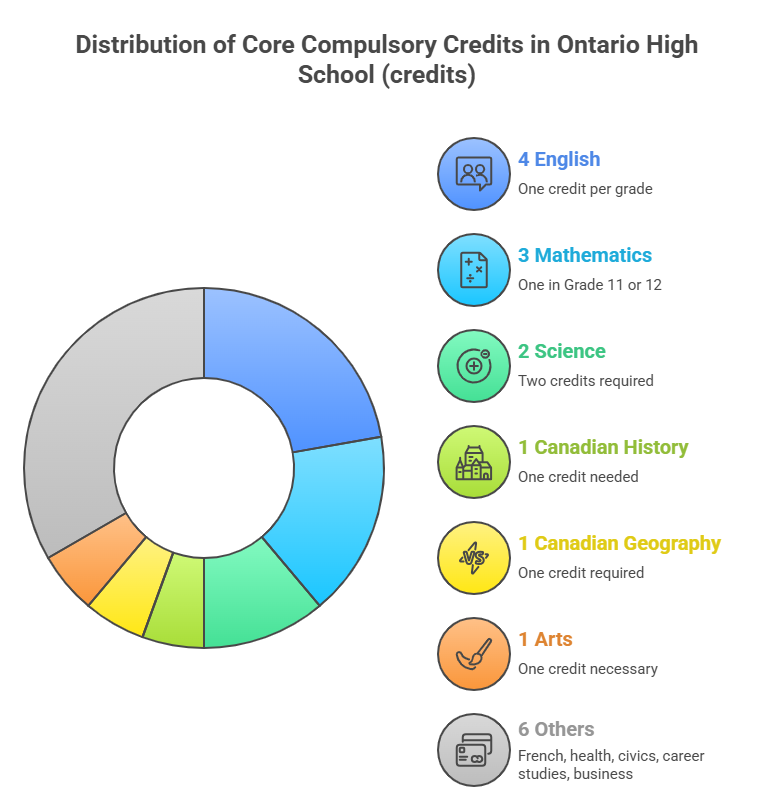Key Highlights of How Many Credits to Graduate High School in Ontario
Getting your diploma from an Ontario secondary school can be simple if you know what to do. Here are the main graduation requirements you have to meet:
- You have to finish 30 credits in total. This is the main graduation requirement for every student.
- Out of these, 18 are compulsory credits and 12 are optional credits.
- You need to do 40 hours of community involvement before you finish secondary school.
- The literacy test requirement must be passed.
- You will also need to complete two online learning credits before you can graduate.
With all these steps in mind, you will be on your way to your Ontario secondary school diploma.
Introduction
Are you thinking about how to get your high school diploma in Ontario? Knowing the steps can help you plan your time as a secondary school student. The Ontario Secondary School Diploma (OSSD) opens new doors for more education and future jobs. Here, you will learn what you need to do to finish your secondary education, including how many credits to graduate high school. This guide will show you the OSSD rules, like how many credits you need and what else you must do. Let’s help you get ready to finish your secondary school program and receive your high school diploma.
How Many Credits to Graduate High School in Ontario
To get your Ontario Secondary School Diploma, you have to finish 30 credits in high school, which includes the online learning graduation requirement. You can think of these credits as building blocks in your secondary school education. Each credit shows that you have finished a course with 110 hours of work. This graduation requirement helps give you a good all-around education. It will help you no matter if you want to go to college, university, or start to work after graduating.
The 30 credits for your secondary school diploma fall into two groups. You will need to earn 18 compulsory credits, which are classes that every student must take. The other 12 credits are optional credits, also called elective credits, and you get to choose these. You can pick topics that interest you or match your career plans, such as a native languages course. There is one thing to keep in mind if you are starting Grade 9 in 2024 for your secondary school. In that case, you need 17 compulsory credits and 13 optional credits. You also must get an additional credit from a STEM-related area for your high school diploma.
What Is the Ontario Secondary School Diploma (OSSD)?
The Ontario Secondary School Diploma, commonly known as the OSSD, is the primary diploma awarded by the Ontario Ministry of Education to students who are at least 18 years of age upon fulfilling graduation requirements. This diploma is recognized by educational institutions and employers in Canada and abroad, signifying that a student has completed high school in Ontario. Earning your OSSD is crucial for admission to universities and colleges, as it demonstrates proficiency in various subjects and readiness for further education or employment. More than just a certificate, the OSSD represents a student’s dedication and effort throughout their academic journey in both elementary and secondary education.
Overview of the OSSD and Its Importance
- The Ontario Secondary School Diploma (OSSD) is awarded when students complete all required coursework, including key subjects like Career Studies and Civics, preparing them for life after high school.
- Knowing how many credits to graduate high school is crucial; the OSSD requires more credits than the Ontario Secondary School Certificate (OSSC), which needs only 14 credits, and the Certificate of Accomplishment for those not meeting diploma requirements.
- Earning the OSSD is essential for students aiming for college, university, or other post-secondary options, as it demonstrates completion of a comprehensive academic program and opens up future opportunities.
Graduation Requirements for Students Starting Grade 9 Before and After 2025
The path to graduation has some slight variations depending on when you began your high school journey. The core requirements, like the total number of credits, the literacy requirement, and the hours of community involvement activities, remain consistent. However, the breakdown of compulsory credits, including courses related to the understanding of First Nations, has changed for students entering Grade 9 in the 2024-2025 school year.
This new requirement aims to strengthen skills in key areas. One notable addition is a compulsory credit in technological education for the newer cohort. Furthermore, a financial literacy graduation requirement will be introduced in 2026 as part of the Grade 10 math course at the academic level.
Here’s a simple breakdown of the main differences:
| Requirement | Started Grade 9 in 2023-24 or Earlier | Started Grade 9 in 2024-25 or Later |
|---|---|---|
| Total Credits | 30 | 30 |
| Compulsory Credits | 18 | 17 |
| Optional Credits | 12 | 13 |
| Online Learning Credits | 2 | 2 |
Credit Breakdown: Compulsory, Optional, and Additional Requirements
To meet the 30-credit graduation requirement in high school, you need both compulsory credits and optional credits. The compulsory credits make sure you learn important things in main subject areas. You have to pass these courses, as they are needed for all students in Ontario.
With optional credits, you get to choose courses that match your interests. These elective courses also count toward your total graduation credits. They are an important part of reaching the 30-credit goal, especially for mature students. In the next sections, we will talk about what compulsory credits and optional credits mean, as well as other parts of your graduation requirement you need to know.
List of Compulsory Credits and Subject Areas

To graduate high school in Ontario, you must complete 18 compulsory credit selections from a range of subject areas. These courses help you build essential skills and knowledge in fields like English, science, and Canadian studies, preparing you for future opportunities. For example, at least one mathematics course must be taken in Grade 11 or 12, and you’ll also learn about creative arts, career studies, and civics.
Here are the core compulsory credits you need:
- 4 credits in English (1 every grade)
- 3 credits in Mathematics (one in Grade 11 or 12)
- 2 credits in Science
- 1 credit in Canadian History
- 1 credit in Canadian Geography
- 1 credit in the Arts
Additionally, you need credits in French as a second language, health and physical education, civics, career studies, and three more from specific groups like business studies.
Optional Credits and How to Choose Them Wisely
Your 12 optional credits let you customize your high school experience. By choosing electives, you can explore your interests, discover new strengths, and prepare for future college plans. Picking wisely makes high school more enjoyable and helps you move forward after graduation.
When selecting optional credits, consider your interests and post-secondary goals. Check your school’s course calendar for all available options, including technological education and cooperative education. Cooperative education offers hands-on work experience, which is valuable for future careers.
Here are some tips that can help you:
- Try out subjects you care about the most.
- Pick courses you need to get into college or university later.
- Choose something new so you might find another thing you like to do.
- Think about going for a cooperative education placement to get real-world work skills.
Literacy Test, Community Hours, and Online Learning Credits
- In addition to meeting the “how many credits to graduate high school” requirement, students must pass the Ontario Secondary School Literacy Test (OSSLT) or complete the Ontario Secondary School Literacy Course (OLC4O) for the successful completion of the literacy requirement to demonstrate reading and writing proficiency.
- Students are also required to complete 40 hours of community involvement, which helps them learn about civic duty and allows them to start gaining real-world experience as early as the summer after Grade 8. An indication of completion will be entered on the student’s Ontario Student Transcript.
- Finally, students must earn two online learning credits, reflecting the growing importance of digital skills and providing more options for completing their Ontario secondary school program.
Graduation Planning and Common Pitfalls to Avoid
Getting your Ontario Secondary School Diploma needs you to plan ahead. You can’t just go to classes and hope for the best. You need to know what steps to take. Planning your credits early helps you check off every graduation requirement on time. You also get ready for entrance requirements of your school’s program.
If you don’t plan, you might not graduate with your group. You could miss the right prerequisite courses or not get all the compulsory credits. Over the next sections, you will find a simple year-by-year guide. It will help you avoid common problems and keep you moving toward your secondary school diploma at an Ontario secondary school.
Grade-Wise Credit Planning from Grade 9 to 12
A year-by-year plan helps answer the question of how many credits to graduate high school in Ontario, which is 30 credits, including the provincial literacy requirement. By planning ahead, you can complete compulsory credits early and choose electives you enjoy. Meet with your guidance counselor regularly to review your Ontario Student Transcript (OST) and make sure you’re on track for your Ontario Secondary School Diploma (OSSD).
Here’s a simple grade-wise plan for students requiring special education support:
- Grade 9 & 10: Complete most compulsory credits and write the OSSLT.
- Grade 11: Finish remaining compulsory credits and select relevant electives.
- Grade 12: Take courses needed for university or college.
- All Grades: Work toward 40 community involvement hours.
Mistakes That Delay Graduation and How to Fix Them
Sometimes, missing graduation requirements can delay your diploma and affect your future plans. The good news is most issues can be fixed if you act quickly. Common mistakes include not completing 40 community involvement hours, failing required courses, or choosing the wrong classes for your goals. Here’s how to stay on track:
- Incomplete community hours: Confirm your volunteer work is approved and finish all hours before the deadline.
- Failed compulsory courses or literacy test: Retake needed courses in regular, night, or summer school, including a Grade 12 compulsory English course, or take the OLC4O literacy course if required.
- Wrong courses for your pathway: Consult a guidance counselor to adjust or upgrade your courses.
Conclusion
To sum up, knowing the credit rules you need to graduate high school in Ontario is very important, especially when considering how many credits to graduate high school, including the English compulsory credit requirement. The students who are in high school now and those who want to plan ahead need this info. When the students understand things like which credits are needed, which are optional credits, and what extra things are expected like community involvement and passing literacy tests, they find it easier to get through school.
You should also plan early and watch out for problems that could stop you from finishing high school. If you want to learn more, have a look at our blog that talks about ways to get more out of your high school years and some tips on your academic journey.
Frequently Asked Questions
1. Can I earn high school credits outside of regular school hours?
Yes, you can do this. The high school credit system in Ontario lets you finish your credits in different ways. You may get credits by going to night school, doing summer classes, joining cooperative education, or taking online learning credits at approved schools. This means you can finish your secondary education at a pace that is right for you.
2. Do extracurricular activities count toward high school credits in Ontario?
No, things like sports teams or school clubs do not count as course credits. But some of these activities might count towards your 40 hours of community involvement if you do not get paid and if the school board does not see them as ineligible activities. The school only gives credits for academic courses.
3. Are international or out-of-province credits accepted toward Ontario graduation?
Yes, credits from other places or countries can be used, including expressions of First Nations. The Ontario Ministry of Education looks at the education of international students to see if their credits match what’s needed. If they do, these credits will be added to your Ontario Student Transcript. Private schools like USCA Academy help students with this process so they can meet entrance requirements.
4. Is it possible to earn high school credits while in middle school?
In most cases, you will not get credits from elementary school that count toward your Ontario Secondary School Diploma for English language learners. High school credits are a part of the school’s program that starts in Grade 9. So, you must be in secondary school to get credits for your diploma. There is one exception. Sometimes, if you start online learning in Grade 8, you can get high school credits under special rules. This does not happen often, but it is possible in some cases. If you need more help, talk to your school.









